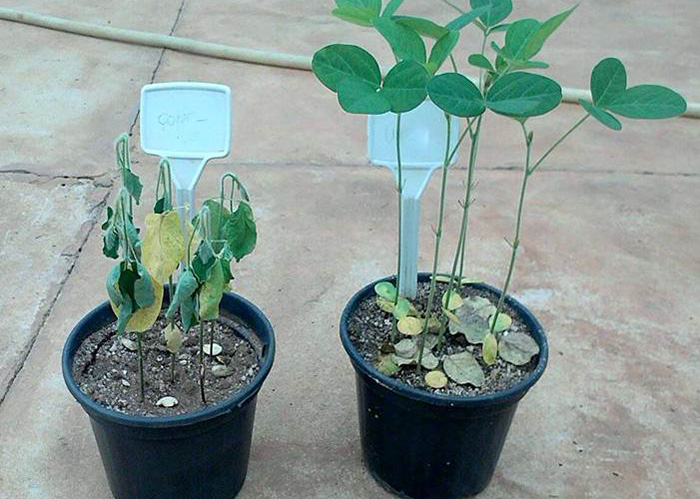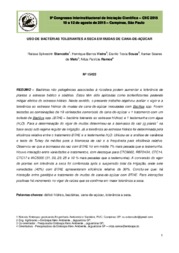Scientists use bacteria to help plants resist droughts
Scientists use bacteria to help plants resist droughts
A group of bacteria has great potential to help plants to suffer less from the effects of water scarcity. Through a study that is unprecedented for tropical agriculture, researchers from Embrapa Environment (Jaguariúna, SP) discovered that the microorganisms can reduce the effect of water stress in soybeans, maize and wheat crops, and enable greater growth of such plant species.
Scientists' expectation is to make use of the bacteria in the near future to treat seeds of different agricultural species, especially in regions with low rainfall such as the Brazilian Semiarid and for very drought-sensitive crops. The idea is to supply bacterial cells for seed treatment.
“For the time being, this is the only study regarding this technology in tropical agriculture, which in fact suffers the greatest impact from droughts”, stresses Itamar Melo, the Embrapa researcher who conducted the research. The inspiration for the work came from nature. Xerophytes, plants that are adapted to semiarid and desert climates, associate with such microorganisms that help them develop cell protection mechanisms against water stress. The idea is to use such bacteria in cash crops that, due to climate change, tend to increasingly suffer from reduced water supply. The microorganisms hidrate roots or interfere in plant physiology, and thus plants become more able to withstand water stress.
Drought is an environmental factor that limits plant growth and one of the natural phenomena that most impacts agricultural productivity. Plant response to water stress is complex, as it involves coordination between gene expression and integration with hormones. One of the most important responses to stress is the so-called osmotic adjustment, which consists in the accumulation of solutes by cells, allowing the plant to absorb water without losing turgidity, the consistency that has it remain rigid.
Embrapa's studies have shown the potential of bacteria that work in this mechanism to mitigate the effect of water stress while promoting the growth of plant species. The results suggest that such rhizobacteria have a strong impact in some stress tolerance mechanisms, which jointly result in the improvement of the cell processes that work to mitigate stress.
One of such mechanisms is the production of compatible osmolytes, small organic molecules selected to counterbalance environmental stresses in living organisms such as betaines, and the formation of biofilms. The researcher Itamar Melo explains that biofilms are formed by rhizobacteria. “They are multicellular aggregates that adhere to the surface of the roots by producing substances such as exopolysaccharides, proteins and DNA,” he details.
How the mechanism operates
Melo reports that when drought-tolerant bacteria colonize the root systems of plants under abiotic stress, they produce substances that hidrate the roots called exopolysaccharides. In order to have such microorganisms reach the plants, a simple procedure is made at the time of sowing, as the scientist explains: “the bacteria are mixed to the seeds when they are sown, in a liquid suspension, which can be water”, details the scientist.
Bacterial cells are developed in labs and immobilized in alginate to treat the seeds of different plant species. This means that such bacteria can be regularly produced in conventional fermenters whose cells are used for seed treatments.
Caatinga Bacteria
The Caatinga, an exclusively Brazilian biome located in the country's Semiarid Northeast, offers xerophytes with high resistance to drought periods. Such plants are combined with microorganisms that are also well-adapted, as they have developed cellular protection mechanisms against water stress as well as plant protection against the negative effects of desiccation.
The study aimed at a better understanding of the bacteria associated with the Caatinga cacti, analyzing the structure of the soil bacterial communities and of the Cereus jamacaru rhizosphere during the transition from the rainy season to the dry one, identifying dominant groups and discussing some of the functions that make a sustained soil-cacti-microorganism interaction possible during the drought period.
Another goal was the selection of drought-tolerant bacteria that could promote plant growth under water stress. Samples were collected throughout the Caatinga in five states: Bahia, Ceará, Piauí, Paraíba, and Rio Grande do Norte. With the use of methodologies that are not crop-specific, it was possible to observe that the time of sampling, the rainy or the dry season, was the main factor responsible for the change in the structure of the bacterial communities.
The phyla Proteobacteria and Bacteroidetes were abundant during the rainy season, while the phyla Actinobacteria and genus Bacillus abounded during the period of drought. Crop-dependent methodologies were used to frequently isolate Bacillus lineages, which develop in mediums with reduced water activity and with some protection mechanisms against desiccation like the production of exopolysaccharides and biofilm.
Moreover, some lineages presented direct or indirect plant growth promoting mechanisms, such as the production of phytohormones, availability of phosphorus through solubilization, nitrogen fixation, and reduction of the negative effects of stress caused by ethylene. A Bacillus sp. lineage was capable of promoting the growth of maize under water stress, an addition to some of the plant parameters analyzed. This study was part of Vanessa Nessner Kavamura's PhD thesis from the University of São Paulo Luiz de Queiroz College of Agriculture (Esalq-USP).
“However, from the laboratory to the fields, there is a long path to follow. We have already partially sequenced and annotated the genome of a rather promising isolate that has presented traits like the production of aminoacids and exopolysaccharides that can help protect against the negative effects of water stress. And, though we have identified some bacterial isolates that showed promising results in greenhouse tests, more tests are required to verify, for instance, whether this performance also applies to field conditions and whether the same results are observed in other plant species. This would provide continuity to the development of biological formulations that could be used in dry areas in the future, like the ones observed in the Semiarid Northeast”, argues Vanessa Nessner Kavamura, who currently is a postdoctoral researcher at Rothamsted Research, in England.
The postdoctoral scholar Suikinae Santos, who participated in the study, explains that the project aimed at exploring drought-tolerant bacteria with mechanisms to promote the growth of maize (Zea mays L.) under water stress, suggesting biotechnological strategies to mitigate problems in croplands that are submitted to long dry spells or are undergoing desertification processes. “The results could be incorporated into public policy action plans for the sustainable development of areas that are subjected to droughts to recover regional agricultural productivity and reduce related economic impacts,” she believes.
In the opinion of the researcher in natural products from Embrapa Environment Antonio Cerdeira, the study was important both from an academic and from a social point of view. “The development of techniques to protect plants against droughts consequently leads to increased production and to improved the quality of life for the inhabitants of the Caatinga,” he states.
Translation: Mariana Medeiros
Cristina Tordin (MTb 28499/SP)
Embrapa Environment
meio-ambiente.imprensa@embrapa.br
Phone number: +55 19 3311-2608
Further information on the topic
Citizen Attention Service (SAC)
www.embrapa.br/contact-us/sac/





